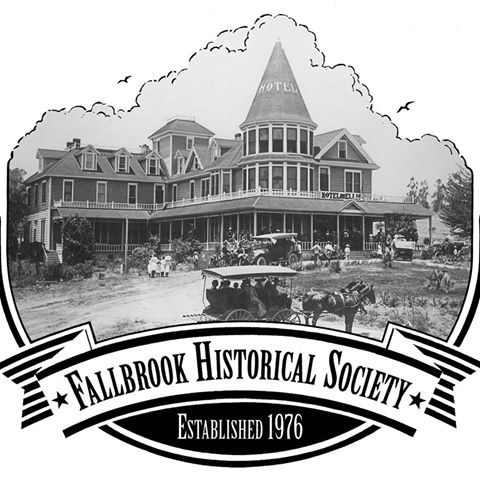Native Americans: Native Americans inhabited the San Luis Rey Valley for thousands of years before the arrival of the Spanish. (1 The natives called themselves the Payómkawichum,” which means “People of the West.” (2
First Europeans: Spanish soldiers and their families are the first settlers in the area following the establishment of the California missions. Mission San Luis Rey was established in 1798. The Payómkawichum are renamed as the San Luiseños by the Spanish.
Rancho Monserate: In 1846,Ysidro Alvarado, the son of a Spanish soldier, was the first European settler of the future Bonsall/Fallbrook area in 1846. Alvarado’s family owned and were living on the 13,322-acre Rancho Monserate spanning both sides of the San Luis Rey River, before California became a U.S. State. (3
Mount Fairview: B. F. Jones of Pennsylvania, may be credited with naming Mount Fairview, the settlement that would eventually become Bonsall. Benjamin Jones is listed as owner of a general merchandise store in the 1870 U.S. Census for the San Luis Rey township. (4
Some of Jones’ immediate neighbors listed in the Census are the Pico family of Rancho Santa Margarita and the Couts family of Rancho Guajome. B.F. Jones was promoting a townsite in the early 1870s that he laid out on property he acquired. Surrounded by the Mexican Ranchos, his Mount Fairview, was located on a promontory on the south side of the San Luis Rey River, just downstream and west of Alvarado’s Rancho Monserate. The promontory overlooked Moosa Canyon to the south and the San Luis Rey River to the north. Matthew Ormsby from Texas was on Rancho Monserate for the 1870 census, but he and his family settled in Mount Fairview in 1871.
How Bonsall got its name: The original name was Mount Fairview. Early settlers probably used the SanLuis ReyPost Office, as Mt. Fairview’s neighboring community of Moosa did until 1882. (5 A Mount Fairview school district was carved out of the San Luis Rey school district by the San Diego County Board of Supervisors in June 1873. The Mount Fairview schoolhouse was already in operation before 1873 and being used as the polling place for the Mount Fairview Precinct. (6 The exact location of this early Mount Fairview School is not known, but is generally thought to be not far from the subsequent school buildings later built here on Old River Road. See Bonsall schoolhouse below.
Osgood: For a few years the Mount Fairview settlement adopted the name Osgood. In the late 1870s, the California Southern Railroad was conducting land surveys in the area for a railroad that would run from National City in San Diego to Colton. The residents of Mount Fairview wanted the railroad to choose a route that ran along the San Luis Rey River and through Mount Fairview. To encourage the decision, Mount Fairview renamed their town to Osgood honoring chief engineer Joseph Osgood of California Southern who was in charge of the railroad survey crew in 1880. (7
Jack McGinnis opened a blacksmith ship in Osgood in 1881. (8 The name change didn’t work. California Southern Railroad instead selected a route along the Santa Margarita River near Fall Brook. By 1885, the little settlement along the San Luis Rey had returned to calling itself Mt. Fairview. (9
Post Office for Fairview: Residents of the small town petitioned the federal government in February 1890 for a “Fairview” Post office. But it was too late, Postal authorities rejected the name because it was too similar to the name already given to Fairfield, CA. (10 The Fairview residents then submitted three new names for the town: “Reed,” for Arabel Reed, the owner of a 40-acre tract of ranch land; “Favorite,” for Grace V. Favorite, stepdaughter of a rancher named H.S. Ehrman; and “Bonsall,” for James Bonsall, a retired minister with a fruit tree nursery on Gopher Canyon Road. The federal Postal Service selected the name “Bonsall” in1889. H.S. Ehrman served as the first postmaster when the Bonsall post office opened in 1890. (11
The Bonsall post office was a tiny five-by-five-foot space inside a new general store in the south bank of the San Luis Rey River where the Bonsall Community Church now stands at the junction of El Camino Road and Old River Road. In the early 1900s the landmark store here was now known as George D. Stevens & Co. George Dana Stevens was from Maine.
Mt Fairview Township: In October 1893, despite having the official Bonsall Post Office, Fairview was officially surveyed as a townsite. The new township of Fairview was described in the San Diego Union as “being located at Bonsall on the San Luis Rey River, on the road from Vista to Fallbrook. The locality has had a post office, a store, and a blacksmith shop that for years has enjoyed a good trade.” (12
Agriculture: In the 1900 Census, Bonsall and the surrounding area is mostly rural. Over 20% of the population are farmers, or have related agriculture occupations. (13 The community was one of large ranches and small farms. The valley floor had several dairies of good size, registered Herford cattle, wine grapes, truck farms, chicken, turkey and olive ranches, pig farms, the Johnson ostrich farm and several rabbitries. Some people raised thoroughbred horses. Bees were plentiful. All water was pumped from wells along the river.
By the 1910s, the Rancho Monserate which once had thousands of horses and cattle was gradually being divided up. Lugardo (Alvarado) Palomares, who grew up here on the San Luis Rey, had orange orchards on her property. George Morris had 600 colonies of bees on his place. The large Canfield Ranch, managed by Ben Thorpe, grew wheat and ran livestock. Tom Hurley owned a prosperous Poultry farm. In 1930, Los Angeles born Hensen Garrett was modernizing the Ideallo Dairy and bottling milk.
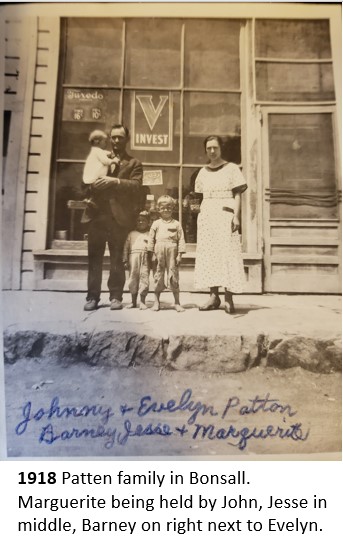
Perry’s Market: When George D. Stevens died in 1921, his longtime clerk and boarder John Patten from Louisiana, inherited the store. John Patten and his wife Evelyn (Freeman) ran Patten’s store until John’s death in 1937. Evelyn, who was born in Bonsall in 1884, sold the historic Stevens/Patten store to Wilson Perry, from Oklahoma, in 1945. Wilson operated Perry’s General Store and Café located at the corner of Olive Hill Rd and Hwy 76 from 1945 to 1981. (14
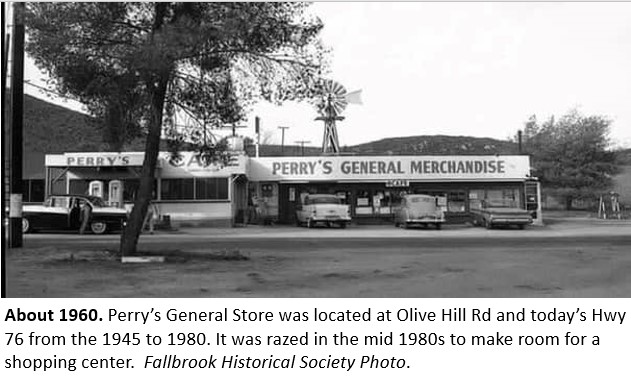
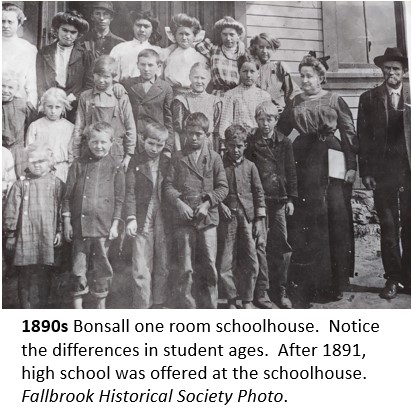
Bonsall Schoolhouse. In 1895 a new Mount Fairview schoolhouse was built on a 150’X 200’ lot donated by W.A. Stratton. A $900 bond at 7% interest is passed with all 21 voters of the district approving. Miss Elsie Averill was the first teacher at $60 month. (15
In 1919, the new Bonsall Union School District was created by combining four area schools; the Monserate school in Couser Canyon, the River school on North River Road, and the Oaks School in Moosa Canyon. Miss Matilda O’Neal was elected principal at the meeting at a salary of $100 per month, Miss Roberta Ellis was teacher for $90 a month. (16
In 1920, a $15,000 bond built a new and larger Bonsall School, that was dedicated in 1922. The modern Bonsall school has expanded on this same property.
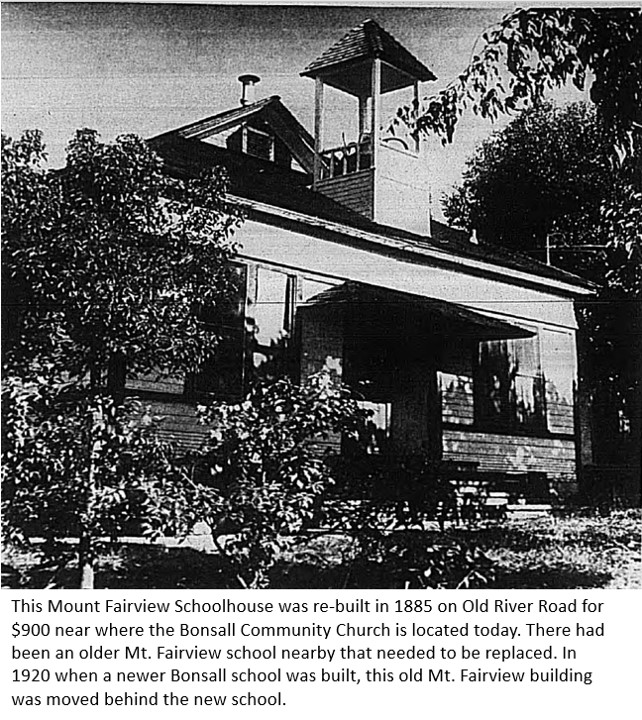
The Bridges of Bonsall. The village of Bonsall/Mount Fairview owes its location for being located near a natural ford of the river. Benjamin Jones had selected a site for his store between the Ranchos that was on the path to a ford across the San Luis Rey River that linked the Old River Road to points north of the river.
The first Bonsall bridge was a wagon bridge built in 1906. It lasted 10 years, before washing away in the 1916 flood. A 2nd one lane replacement bridge was quickly built by the County just months later. This second bridge was in use for another 11 years, before it too washed away in 1927. Fortunately, a 3rd bridge, a larger 630-foot 2 lane concrete span, was already completed and open in 1926. This 3rd bridge is still standing and is on the National Register of Historic Places as the last remaining Mission Arch bridge. Today, in the 21st century, the San Luis Rey River is crossed with a 4th bridge, a modern 4 lane span with shoulders that is part of Hwy 76. For more discussion and pictures, see Bonsall Bridge by the Fallbrook Historical Society. (17
Tom Frew,
FHS Historian
Footnotes
1) UC San Diego, Chronology of the Indigenous Peoples of San Diego by Nancy Carol Carter.
2) Pechanga Band of Indians history.
3) Historic Ranchos of San Diego by James Copley, Union Tribune Publishing, 1969
4) U.S. Census, San Luis Rey 1870. Jones info is recorded on August 8, 1870.
5) The Lives of Four Sisters by Nettie S. (Tomlins) Ely at Fallbrook Historical Society.
6) San Diego Union, July 13, 1873. This is 10 years earlier than reported by the Bonsall PTA
7) San Diego Union, Sept 21, 1881.
8) San Diego Union, August 7, 1885.
9) San Diego Union, August 11, 1885.
10) San Diego Union, March 15, 1981
11) San Diego Union Tribune, June 17, 2007.
12) San Diego Union, October 16, 1893.
13) 1900 U.S. Census. Notes at Fallbrook Historical Society
14) Obituary of Wilson Perry, Fallbrook Enterprise, September 10, 1987
15) The Little Old Bonsall School house by Virginia Funk, Bonsall’s Woman’s Club 1984.
16) ibid
17) See Bonsall Bridge, Fallbrook Historical Society Winter 2024 Historian.
